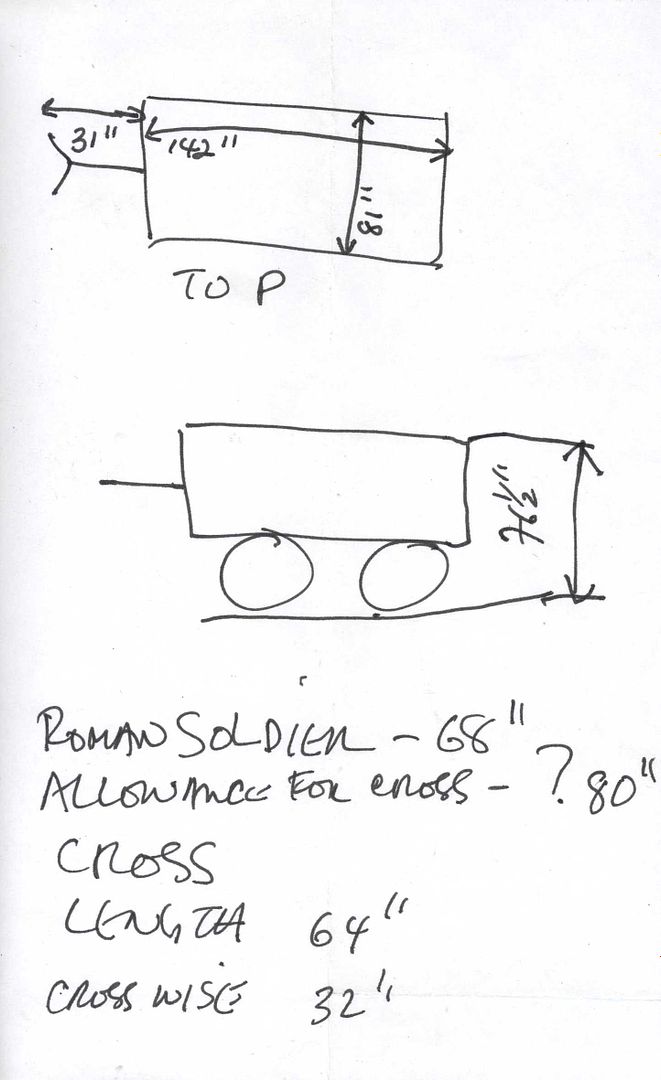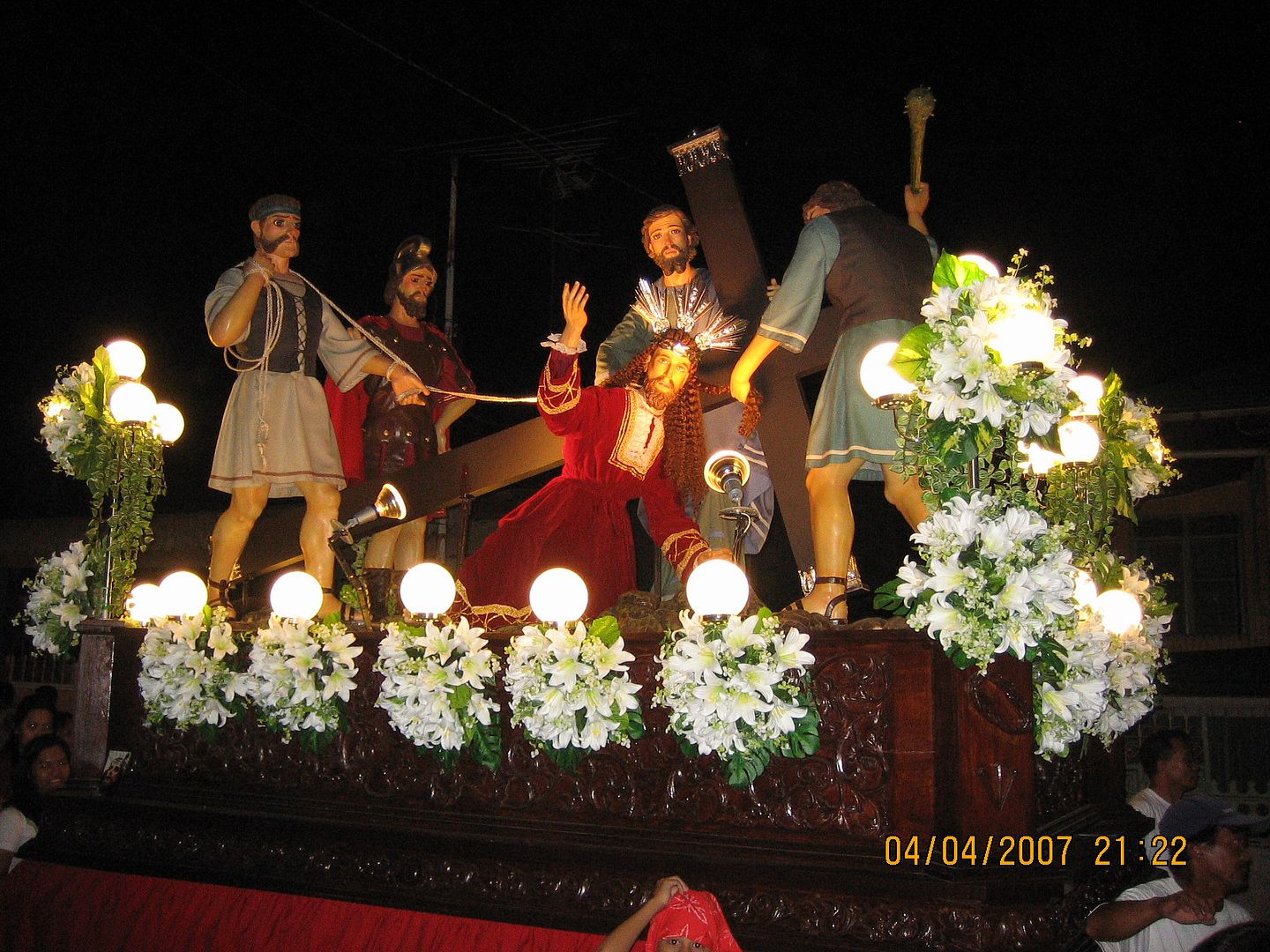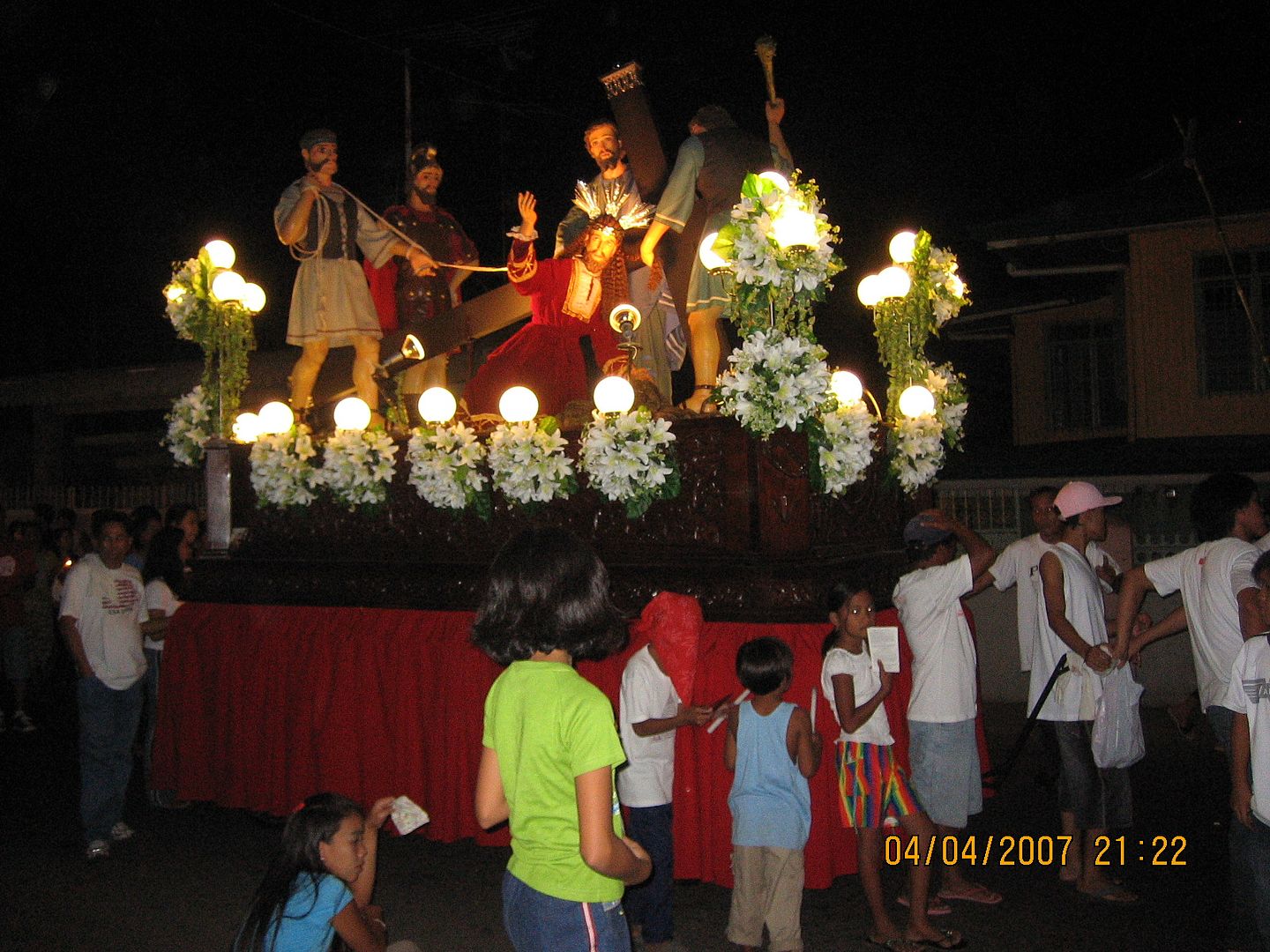What seemed like a pretty straightforward commission - deliver - set-up - go process for this Holy Week paso wasn’t really. Although the yard of our ancestral house was large and expansive, there wasn’t actually any built structure available to house the carroza there. (That’s still a future family project.) Instead, several weeks before that setting-up day on Palm Sunday Eve, my aunt asked a relative, who lived diagonally across and had a large rice mill (“kiskís,” as we call it there), now idle, if we could use her space to park the carroza and set up the paso there.
At first, the relative agreed, but within days, the offer was quickly rescinded. As it turns out, she was a member of an iconoclastic “born-again” sect in the local community, and in fact the mothballed kiskís was used for their regular prayer gatherings. She feared, quite rightly, that her co-religionists might expel her for welcoming her staunch Roman Catholic relatives’ processional tableau into her kiskís. Imagine them worshipping on Palm Sunday and denouncing the evils of “graven images” while seated right next to our “Pagkarapâ” – that would be quite surreal. (What I would give to see that on video!)
Fortunately, there was another alternative, which involved the rice granary (kamalig, as we call it) of another aunt, actually the next-door neighbor to our ancestral house. Like the kiskís across the road, the kamalig had a large garage right in front of it, and both structures adjoined this aunt’s own ancestral house. She was frequently not in residence, as she lived, and ran a thriving business, in another part of town, rearing thousands of heads of pigs (a lucrative industry in these parts). But she very kindly let us use her wide, empty, and tall-ceilinged kamalig-garage for our new processional paso.
One of the risks that we foresaw with this processional tableau was its height. Based on a diagram that Kiko Vecin scribbled, the carroza itself was about (in metric terms) 206 cm wide, 360 cm long, and 195 cm tall.
This is actually not very large, considering how massive and formidable it appears in person and in pictures (see Parts Two and Three). Its length and width were well within the normal limits for unarticulated road vehicles. However, laden with the tableau, its overall height rises to about four meters, or more than thirteen feet – still within the international minimum vertical clearance standard of 427 cm (fourteen feet), but certain to pose problems in some places.
And in fact, as we were setting up the tableau on the carroza in that space next to the kamalig that Palm Sunday Eve, a real problem slowly dawned on us – we were trapped! While the ceiling in the center of the garage was more than fourteen feet high, the roof sloped steeply downwards towards the entrance, such that at least the mace of the temple guard, the tip of the cross, and the captain’s helmet would have to be removed if we wanted to wheel the carroza out into the driveway and onto the road.
Clearly, the prospect of detaching and reattaching parts of the tableau upon leaving and entering this garage was no good. This called for drastic action. We then called our master carpenter (who had also worked on the restoration of our own ancestral house next door over the previous two years), and presented the problem to him. He quite confidently recommended that the roof at the entrance be dismantled, and a new inverted-V-shaped structure be constructed to replace it, at the required fourteen-foot vertical clearance. We then quickly obtained the owner’s permission, and had our carpenter start hacking away, ensuring that the Pagkarapâ paso could move in and out freely.
Well, not by itself obviously. For the Holy Wednesday procession that was scheduled to begin at
This seemingly fast speed for what appears to be a bulky and heavy paso is no doubt attributable to the fact that its processional vehicle was actually very easy to “drive” – once we got over the virtual hump of moving it from a standing stop to a cruising speed, the well-engineered low-friction axles and wheels of the carroza and the nominal brawns of half-a-dozen assorted cousins, childhood playmates, and neighbors made the journey sufficiently zippy. In fact, I recall that we even overtook an ice cream vendor and his pushcart along the way. (Admittedly, he wasn’t after speed, but still….)
We were then asked to park in the yard of the public school across the church. The church had no churchyard as such; in my childhood it was just an unassuming visita where an obviously old (some say 18th century), reputedly miraculous (unsurprisingly), half-life-sized image of the Crucified Christ was venerated. Having been upgraded to parish church status a few years ago, certain improvements to the building fabric and physical facilities had since been undertaken, but since land does not materialize from nowhere, the schoolyard across the road is regularly commandeered for parking and other similar needs, making us grateful for this union of church and state at the barangay level.
The Holy Wednesday procession was lengthier than I had expected – over three hours long, and winding down the main road in an easterly direction, off to a side road that leads to the main highway, back to the main road, off to another side road that loops around the neighboring barrio, back to the main road, then back to the church.
But throughout the long evening journey, this well-lit, generously-elevated, and elegantly-designed paso of “Ang Pagkarapâ ng Panginoon” was a consistently effective medium for public devotion and personal reflection, and perhaps private awe as well.
They had also armed themselves well for the actual procession with not just one but two twelve-foot bamboo poles with triangular ends, which wise carroza operators far and wide know to be an essential tool in this activity. The idea behind having two poles was to ensure that even in the most densely-obstructed side streets, all low-hangers could be well-managed. And if not, we would attach a sharp pair of garden shears to one of the poles and snip those pesky wires out of the way. Fortunately, no such violence was found to be necessary during this Holy Wednesday procession, as even the most problematic-looking areas were navigated through quite smoothly.
In contrast, some of the devotees walking with the Pagkarapâ would even say, “Oh, it’s so good of you to have used batteries instead of a noisy generator.” Sometimes it was difficult to decide whether to ‘fess up and give up the illusion, or to say, “Yes, well, we really wanted our paso to be quiet and conducive to prayerful reflection.” Ha ha ha.
And the best part was that throughout the nearly four hours that the carroza had to be lit that evening, including the journey at the end of the procession from the church back to its home base, not once did the tiny generator fail. Whether from the front or the back, the paso was always well-lit, bathed in warm light, and a feast for devout eyes.
For Good Friday, we knew the routine – leave home base at around
The main difference was that there were far more people this evening than two nights previously. Obviously, more hometown kids were back from the city or wherever they were on Wednesday, which was still a regular working day. I’d like to think though that people heard about “that exceptional new paso” in Caingin,
From my observation during both evenings, the most common response to the Pagkarapâ was a silent stare, no doubt because its unusual staging versus other equivalent tableaux required greater-than-average focus and concentration to fully appreciate the action – the hair-pulling, the noose around the neck, the mace raised to strike – and to absorb the total effect of the tableau. But based on the expressions on the faces of the observers, there is little doubt that it got its message across.
To exorcise ourselves of whatever evils those orbs (and any humans of ill will around) might be giving off, our always-reliable parish priest set himself up on a high platform, blessing the pasos as they returned to the church. This he did by dispensing heavy clouds of incense, enough to mask the more intense odors of devotees after hours of walking in the hot summer night. And as if that wasn’t enough, he also sprinkled holy water generously on the devotees themselves, providing some nominal moisture to the hot, dry, still, and stale air.
There was one last special touch that we had for Good Friday. On his own initiative, my enterprising young cousin had printed off some custom-designed shirts for all our invited Pagkarapâ-ers to wear. These apparently had been silkscreen-printed only within the last couple of days, but all who had been specifically invited by the family had at least some “uniform” to wear that evening, which would subsequently be a nice souvenir and token of appreciation as well. Here, you’ll see some members of the Pagkarapâ gang wearing them as they manoeuvre the carro (more difficult than it looks, if you’ve not done it before) back into the garage.
Next year, we’ll try for Nazareno-red golf shirts, if we can afford it. And matching tres potencias on headbands, why not? Ha ha.
The carro having been repositioned in place, it was another good time to go for some Kodakán.
And finally, just my aunt and cousins as before:
Then after a modest repast of munggó with tinapá and other abstinence-observing dishes, it was time for everyone to get some much-needed rest. The paso itself would remain in the garage throughout the Easter weekend, available for viewing by friends, relatives, neighbors, or the simply curious. Easter Monday, being a public holiday this year, was a good time for my cousins to take everything down, pack away the flowers, fold away the sayál and the garments, and set the images aside. The bodies were to be stored away; the supporting characters’ heads were to be placed on custom-made stands and kept inside an aparador to protect them from damage, and the Christ’s head and hands were to be displayed in our ancestral house’s living room, inside a beautiful antique balayong hardwood urna, also acquired from the Vecin Collection.
Thus passed quite uneventfully (no news is good news!) the Pagkarapâ’s first Holy Week run. Salamat sa Diyos! Until next year. Let’s see if those orbs will decide to reappear.
- - - -
Watch out for future features from the SS-Files (Semana Santa Files), including exciting Holy Week reportage from various fields and fountains, moors and mountains. (Wait -- that’s Christmas! Ha ha.)
- - - -
nsconsolacionycorrea wrote on Apr 27, '07
Hay!....DEO GRATIAS!!!...
Congratulations to your family for the Primera Salida Procesional of your Tercera Caida tableau. |
robbyandharry wrote on Apr 27, '07
lol... leo, those orbs really loved your tercera caida... so many orbs in san rafael... maybe dead animals... (parang kilala ko itong line na to a...) hehehe
btw... congrats po for this wonderful tableau... now we have to wait for "Ang Banal na Hapunan" tableau... panigurado, idodocument mo yon mula sa paglililok hanggang sa paglabas... :) |
dennisraymondm wrote on May 1, '07, edited on May 1, '07
Yup! At last I thought I was the only one capturing these ORBS! Most of the pics I took inside churches had these orbs and they occur only in churches and in cemeteries (as with my case). Just this morning, I took a shot at the altar of the Divina Pastora in Gapan, N.E., (my maternal grandparents' hometown) since it's her fiesta and lo and behold, two swirling orbs appeared. They seem to appear only in particular churches coz like last year, orbs appeared in my shots of Panglao and Tagbilaran churches in Bohol but not in other churches. When I returned this year, the orbs appeared only in the Tagbilaran church (since I did go to Panglao church this year) but not in the other churches. The La Salle Chapel in Taft Ave. shots (where the massacre of FSC Brothers, et. al. occured) had a couple of orbs and that was shot during daytime! Pics of the Cubao Cathedral I took last week had orbs galore like the shots of another flickr member done at the same church at a diffrent time! Zooming in on them seem to produce facial images. Well, what more can I say? Happy orb hunting whatever they are!
|
antigualla wrote on Feb 18, '09
Bow! Congratulations for an excellent paso and equally excellent story. Viva El Señor!
|























No comments:
Post a Comment